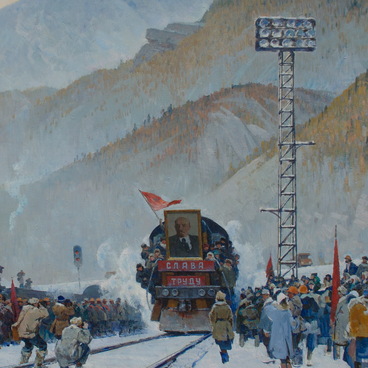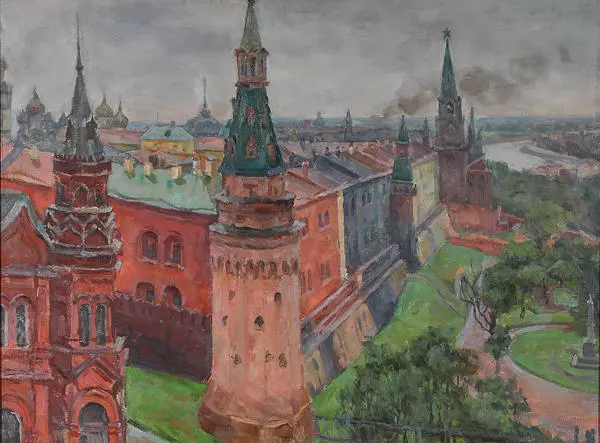The painting by Alexander Osmerkin Back Street in the Crimea shows a narrow village street, along which a polutorka (one and a half ton) truck rides. Lush trees growing behind the stone walls lean over the road; clear blue sky is visible above them. Three people sit on a ledge, but the artist does not focus on their figures: they look slightly blurry, almost merging with the background. Such accessory figures of people are called staffage in landscape painting.
1 / 3
Back Street in the Crimea
Creation period
1936
Dimensions
78,5x56 cm
78.5 x 56 centimeters
78.5 x 56 centimeters
Technique
oil on canvas
Collection
Exhibition
0
Open in app#1
Alexander Osmerkin
Back Street in the Crimea
#2
#10
In his landscape painting, Osmerkin drew inspiration in landscapes by Alexander Ivanov and Nicolas Poussin. The artist even borrowed some techniques from them: he built a composition based on several grounds, used a rich palette and painted objects with rounded outlines.
Alexander Osmerkin. Crimea. Kozy. Evening. Poplar trees. 1938. Source: www.artchive.ru.
#11
Osmerkin worked on the painting Back Street in the Crimea in the village of Kozy. It was there that he supervised the plein air practical training of students of the Vasily Surikov Moscow Institute of Fine Arts. Nowadays, the old village gave place to the township of Solnechnaya Dolina.
#12
Back Street in the Crimea was painted during the realistic period in the creative career of Alexander Osmerkin. The artist wrote that before, he
‘walked a path of analytic research in painting, trying his hand at both impressionism and cubism… “.
#13
Osmerkin was born in Elizavetgrad in 1892. He first studied painting in the drawing classes at the Elizavetgrad Zemstvo secondary school, then went to Saint-Petersburg and entered the Drawing School of the Society for the Promotion of Arts. He studied there for a year, then entered the Kiev Art College, and after that, went to the Moscow school of Ilya Mashkov.
#14
Mashkov was one of the founders of the art association Jack of Diamonds. Under the influence of his teacher, Alexander Osmerkin also joined this group. At that time, he was inspired by the painting style of Paul Cezanne, the works by French cubists and fauvists. The artist socialized with Sergey Yesenin, Anna Akhmatova, Osip Mandelstam. He often argued with Vladimir Mayakovsky about the purpose of art in the era of revolution.
#15
The artist Amshei Nurenberg recalled these disputes:
“Mayakovsky was convinced that during the revolution, instead of sitting in the studio and painting “nice portraits” or “decorous still lives, ” the artist should be “on the firing line” and help the working class. Osmerkin believed that in the days of the revolution, an artist should paint not only propaganda posters, but also easel paintings that can reflect revolutionary events. They always had heated debates, and their conversations often ended in quarrels’.
#17
In the early years of his work, Osmerkin created landscapes in a different style. Their forms were influenced by the cubism: he painted trees and buildings as angular geometrical shapes.
Alexander Osmerkin. Landscape. 1917. Source: www.artchive.ru.
#18
Belgorod State Art Museum
read morehide
00:00
00:00
1x
Back Street in the Crimea
Creation period
1936
Dimensions
78,5x56 cm
78.5 x 56 centimeters
78.5 x 56 centimeters
Technique
oil on canvas
Collection
Exhibition
0
Open in app
Share









